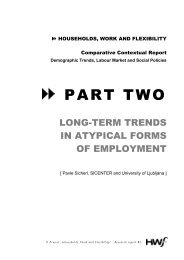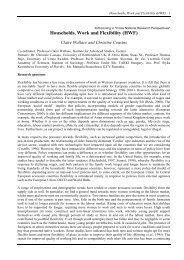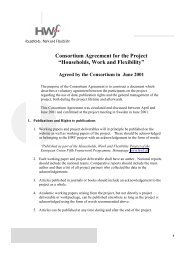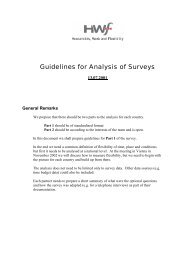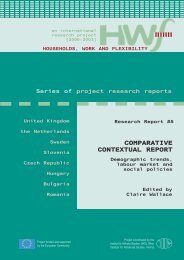CRITICAL REVIEW OF LITERATURE - HWF
CRITICAL REVIEW OF LITERATURE - HWF
CRITICAL REVIEW OF LITERATURE - HWF
You also want an ePaper? Increase the reach of your titles
YUMPU automatically turns print PDFs into web optimized ePapers that Google loves.
Chapter Two. Literature review: UK 31gence of an insecure workforce imposes severecosts on individuals, their families and the widersociety (Heery and Salmon 2000, Burchell et al.1999, Sennet 1998).Burchell et al. (1999) also found that it wasthe core workforce which took the primary responsibilityfor achieving flexibility. This occurredthrough an expansion of their workload,work intensification, increased variation in theirworking hours and location of work and the erosionof their traditional job demarcations. In manycases the increased organisational flexibility isachieved by reducing direct employment throughredundancies, by contracting out and by redesigningthe way work is carried out. There has,therefore, been a significant increase in functionalflexibility of workforces over recent years includingmulti-skilling, multi-tasking, multi-functioning,delayering and the erosion of job demarcations.In addition organisations have pursuedtemporal flexibility by changing working hoursregimes as well as locational flexibility.However, not all these forms of flexibleworking may benefit employers. Recent researchhas stressed the importance of the ‘pyschologicalcontract’, that is, the implicit commitments madebetween the employer and employees. The restructuringof work and an increase in the tenuouscommitment of employers may result in areduction of employees’ motivation, loyalty,commitment and performance, as well as highturnover rates, absenteeism and difficulties ofrecruitment (Guest 2000, Burchell et al. 1999, Purcellet al. 1999).1.3. The Debate on Choice and ConstraintsThe expansion of part-time work in the UK – from3.3 million in 1971 to 6.2 million in 2000 – has alsofuelled considerable controversy and debateabout the role and nature of part-time work in theBritish labour market. This debate can be consideredfrom the demand side or from the supplyside. Explanations which focus on the demandside posit that employers construct part-time jobsin particular ways, for example, to lower costs, tocover for variable customer demand or to increasecompetitiveness of the organisation (Rubery andTarling, 1988, Dex and McCulloch 1995, Purcell etal. 1999).On the other hand, those explanations fromthe supply side focus on lack of investment inhuman capital of those who take part-time employmentas well as the need for women to takepart-time jobs to reconcile domestic commitmentsand childcare with work. More recently womenpart-timers’ lack of commitment to employmentand the view that they give priority to family andhome making has been put forward by Hakim(1991, 1996). In Hakim’s view the growth of parttimework reflects women’s own preferencesabout working hours and a concern to find jobswhich enable them to reconcile work and familylife. She argues that there are two qualitativelydifferent types of working women, the committed‘self-made’ women who work full-time and arecareer-oriented, and the uncommitted ‘gratefulslaves’ who are satisfied with part-time work andgive priority to their domestic commitments.This is a view which resonates with populardiscourse, in that, part-time work in the UK iswidely viewed as ‘not proper work’. The term isoften used in a derogatory way to indicate a lackof commitment to work, for example, leavingwork early or arriving late at work. The term mayalso be used to refer to a secondary tier of supportjobs in an organisation for example, secretaries oradministrative support staff (Gregson et al. 1999).This discourse confirms the (mainly male) fulltimersidentity and position in contrast with theoverwhelmingly female part-timer’s less privilegedpositionCritiques of Hakim’s work have also notedthe negative and stereotypical image of part-timefemale workers embodied in her work (for example,Breugel 1996). While it is the case that thevast majority of female part-timers say that they© Project „Households, Work and Flexibility”. Research report #1



